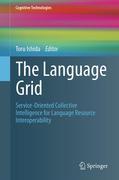
The language grid: service-oriented collective intelligence for language resource interoperability
Ishida, Toru
There is increasing interaction among communities with multiple languages, thus we need services that can effectively support multilingual communication. The Language Grid is an initiative to build an infrastructure that allows end users to create composite language services for intercultural collaboration. The aim is to support communities to create customized multilingual environmentsby using language services to overcome local language barriers. The stakeholders of the Language Grid are the language resource providers, the language service users, and the language grid operators who coordinate the former. This book includes 18 chapters in six parts that summarize various research results and associated development activities on the Language Grid. The chapters in Part I describe the framework of the Language Grid, i.e., service-oriented collective intelligence, used to bridge providers, users and operators. Two kinds ofsoftware are introduced, the service grid server software and the Language Grid Toolbox, and code for both is available via open source licenses. Part II describes technologies for service workflows that compose atomic language services. Part III reports on research work and activities relating to sharing and using language services. Part IV describes various applications of language services as applicable to intercultural collaboration. Part V contains reports on applying the Language Grid for translation activities, including localization of industrial documents and Wikipedia articles. Finally, Part VI illustrateshow the Language Grid can be connected to other service grids, such as DFKI'sHeart of Gold and smart classroom services in Tsinghua University in Beijing.The book will be valuable for researchers in artificial intelligence, naturallanguage processing, services computing and human--computer interaction, particularly those who are interested in bridging technologies and user communities. This is the first book describing the Language Grid, an infrastructure that allows end users to create composite language services for intercultural collaboration.-. The book will be valuable for researchers in artificial intelligence, particularly in the areas of machine translation and human-computer interaction.-. The contributing authors are leading experts in the field of intercultural collaboration, drawn from 7 countries in Asia and Europe. INDICE: Part I – Language Grid Framework Chap. 1 – The Language Grid: Service-Oriented Approach to Sharing Language Resources Chap. 2 – Service Grid Architecture Chap.-3 – Intercultural Collaboration Tools Based on the Language Grid.-. Part II – Composing Language Services Chap. 4 – Horizontal Service Composition for Language Services Chap. 5 – Service Supervision for Runtime ServiceManagement Chap. 6 – Language Service Ontology.-. Part III – Language Grid for Using Language Resources Chap. 7 – Cascading Translation Services Chap. 8 – Sharing Multilingual Resources to Support Hospital Receptions Chap. 9 – Exploring Cultural Differences in Pictogram Interpretations.-. Part IV – Language Grid for Communication Chap. 10 – Intercultural Community Development for Kids Around the World Chap. 11 – Language-Barrier-Free Room for Second Life Chap. 12– Conversational Grounding in Machine Translation Mediated Communication.-. Part V – Language Grid for Translation Chap. 13 – Humans in the Loop of Localization Processes Chap. 14 – Collaborative Translation Protocols Chap. 15 – Multilanguage Discussion Platform for Wikipedia Translation.-. Part VI – Towards Federation of Service Grids Chap. 16 – Pipelining Software and Services for Language Processing Chap. 17 – Integrating Smart Classroom and Language Services Chap. 18 – Federated Operation Model for Service Grids.
- ISBN: 978-3-642-21177-5
- Editorial: Springer Berlin Heidelberg
- Encuadernacion: Cartoné
- Páginas: 285
- Fecha Publicación: 15/07/2011
- Nº Volúmenes: 1
- Idioma: Inglés
